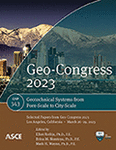Effects of Initial Consolidation on the Triggering of Static Liquefaction Considering Fabric Effects
Publication: Geo-Congress 2023
ABSTRACT
The onset of static liquefaction in anisotropically consolidated soils is of relevance in assessing the performance of geotechnical systems. Previous studies have also highlighted the role of inherent soil fabric. This study derives an analytical instability criterion for granular materials under undrained loading by using the relatively new anisotropic critical state theory (ACST). The criterion is established using the SANISAND-F model, and it is amenable to incorporating consolidation anisotropy and fabric effects. We assess different numerical strategies for simulating the instability onset on materials sheared from initially anisotropic conditions. Our assessments indicate that simulations that consider consolidation followed by shear better represent the response observed in laboratory tests. It is observed that the degree of anisotropic consolidation has no significant effect on the instability stress ratio, but a very high degree of anisotropic consolidation results in a spontaneous collapse. It is also observed that the anisotropic consolidated specimens have a higher instability stress ratio in triaxial compression than in triaxial extension, highlighting the effect of loading direction relative to the existing fabric.
Get full access to this article
View all available purchase options and get full access to this chapter.
REFERENCES
Andrade, J. E., A. M. Ramos, and A. Lizcano. 2013. “Criterion for flow liquefaction instability.” Acta Geotech, 8 (5): 525–535. Springer.
Been, K., and M. G. Jefferies. 1985. “A state parameter for sands.” Géotechnique, 35 (2): 99–112. Thomas Telford Ltd.
Bokkisa, S. V., J. Macedo, A. L. Petalas, and C. Arson. 2022. “Assessing static liquefaction triggering considering fabric anisotropy effects under the ACST framework.” Comput Geotech, 148: 104796. https://doi.org/https://doi.org/10.1016/j.compgeo.2022.104796.
Buscarnera, G., and A. J. Whittle. 2013. “Model prediction of static liquefaction: influence of the initial state on potential instabilities.” Journal of Geotechnical and Geoenvironmental Engineering, 139 (3): 420–432. American Society of Civil Engineers.
Chu, J., and D. Wanatowski. 2008. “Instability Conditions of Loose Sand in Plane Strain.” Journal of Geotechnical and Geoenvironmental Engineering, 134 (1): 136–142. https://doi.org/10.1061/(asce)1090-0241(2008)134:1(136).
Dafalias, Y. F., and M. T. Manzari. 2004. “Simple Plasticity Sand Model Accounting for Fabric Change Effects.” J Eng Mech, 130 (6): 622–634. American Society of Civil Engineers. https://doi.org/10.1061/(asce)0733-9399(2004)130:6(622).
Ishihara, K. 1993. “Liquefaction and flow failure during earthquakes.” Geotechnique, 43 (3): 351–451. Thomas Telford Ltd.
Kato, S., K. Ishihara, and I. Towhata. 2001. “Undrained shear characteristics of saturated sand under anisotropic consolidation.” Soils and Foundations, 41 (1): 1–11. The Japanese Geotechnical Society.
Konrad, J. M. 1993. “Undrained response of loosely compacted sands during monotonic and cyclic compression tests.” Géotechnique, 43 (1): 69–89. Thomas Telford Ltd.
Kramer, S. L. 1996. Geotechnical earthquake engineering. Pearson Education India.
Lade, P. V. 1999. “Instability of granular materials.” Physics and mechanics of soil liquefaction, 3–16. Rotterdam: Balkema.
Li, X. S., and Y. F. Dafalias. 2012. “Anisotropic Critical State Theory: Role of Fabric.” J Eng Mech, 138 (3): 263–275. https://doi.org/10.1061/(asce)em.1943-7889.0000324.
Morgenstern, N. R., S. G. Vick, C. B. Viotti, and B. D. Watts. 2016. “Report on the Immediate Causes of the Failure of the Fundão Dam.” Fundão Tailings Dam Review Panel.
Najma, A., and M. Latifi. 2017. “Analytical definition of collapse surface in multiaxial space as a criterion for flow liquefaction occurrence.” Comput Geotech, 90: 120–132. Elsevier Ltd. https://doi.org/10.1016/j.compgeo.2017.06.005.
Olson, S. M. 2001. Liquefaction analysis of level and sloping ground using field case histories and penetration resistance. University of Illinois at Urbana-Champaign.
Petalas, A. L., Y. F. Dafalias, and A. G. Papadimitriou. 2020. “SANISAND-F: Sand constitutive model with evolving fabric anisotropy.” Int J Solids Struct, 188–189: 12–31. Elsevier Ltd. https://doi.org/10.1016/j.ijsolstr.2019.09.005.
Yang, J., L. B. Liang, and Y. Chen. 2021. “Instability and liquefaction flow slide of granular soils: the role of initial shear stress.” Acta Geotech, 1–15. Springer.
Yoshimine, M., K. Ishihara, and W. Vargas. 1998. “Effects of principal stress direction and intermediate principal stress on undrained shear behavior of sand.” Soils and Foundations, 38 (3): 179–188. Elsevier.
Information & Authors
Information
Published In
History
Published online: Mar 23, 2023
Authors
Metrics & Citations
Metrics
Citations
Download citation
If you have the appropriate software installed, you can download article citation data to the citation manager of your choice. Simply select your manager software from the list below and click Download.
